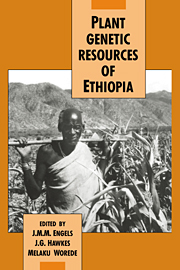Book contents
- Frontmatter
- Contents
- Contributors
- List of acronyms
- Preface
- Part I General introduction
- Part II The Ethiopian centre of diversity
- 2 The Ethiopian gene centre and its genetic diversity
- 3 Crops with wild relatives found in Ethiopia
- 4 Diversity of the Ethiopian flora
- 5 Forest genetic resources of Ethiopia
- 6 Plants as a primary source of drugs in the traditional health practices of Ethiopia
- 7 Traditional aromatic and perfume plants in central Ethiopia (a botanical and ethno-historical survey)
- 8 Spice germplasm in Ethiopia
- 9 A diversity study in Ethiopian barley
- 10 Sorghum history in relation to Ethiopia
- 11 Prehistoric Ethiopia and India: contacts through sorghum and millet genetic resources
- 12 Konso agriculture and its plant genetic resources
- Part III Germplasm collection and conservation in Ethiopia
- Part IV Evaluation and utilization of Ethiopian genetic resources
- Index
9 - A diversity study in Ethiopian barley
Published online by Cambridge University Press: 30 October 2009
- Frontmatter
- Contents
- Contributors
- List of acronyms
- Preface
- Part I General introduction
- Part II The Ethiopian centre of diversity
- 2 The Ethiopian gene centre and its genetic diversity
- 3 Crops with wild relatives found in Ethiopia
- 4 Diversity of the Ethiopian flora
- 5 Forest genetic resources of Ethiopia
- 6 Plants as a primary source of drugs in the traditional health practices of Ethiopia
- 7 Traditional aromatic and perfume plants in central Ethiopia (a botanical and ethno-historical survey)
- 8 Spice germplasm in Ethiopia
- 9 A diversity study in Ethiopian barley
- 10 Sorghum history in relation to Ethiopia
- 11 Prehistoric Ethiopia and India: contacts through sorghum and millet genetic resources
- 12 Konso agriculture and its plant genetic resources
- Part III Germplasm collection and conservation in Ethiopia
- Part IV Evaluation and utilization of Ethiopian genetic resources
- Index
Summary
Introduction
Barley (Hordeum vulgare L.), one of the oldest of cultivated plants, has been grown in Ethiopia for at least 5000 years (Harlan, 1969; Doggett, 1970). Generally, Ethiopia is considered as a secondary gene centre, or a centre of diversity, for barley and not as a centre of origin (Tolbert et al., 1979). However, in recent studies some evidence has been presented to suggest that Ethiopia might be a centre of origin (Bekele, 1983b; Negassa, 1985) as was originally suggested by Vavilov. The diversity in Ethiopian barley germplasm accessions has been presented in a number of studies (Ward, 1962; Tolbert et al, 1979; Bekele, 1983a,b; Negassa, 1985) which were based mainly on discrete (non-continuous) characters. In studies on disease resistance in Ethiopian barley it was found that Ethiopian barley germplasm possesses resistance genes for almost all major diseases (Moseman, 1971; Lehmann, Nover & Scholz, 1976). In addition, high protein and lysine contents have been found in some Ethiopian genotypes (Munck, Karlsson & Hagberg, 1971).
In this chapter a detailed analysis is presented of the phenotypic diversity in the barley germplasm collection of the Plant Genetic Resources Centre/Ethiopia (PGRC/E), which possesses considerably more accessions than have been used in earlier diversity analyses. The results of previous studies on Ethiopian barley germplasm will also be summarized, particularly the ones on diversity indices.
- Type
- Chapter
- Information
- Plant Genetic Resources of Ethiopia , pp. 131 - 139Publisher: Cambridge University PressPrint publication year: 1991
- 7
- Cited by



